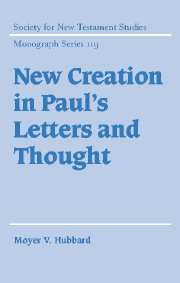Book contents
- Frontmatter
- Contents
- Acknowledgments
- List of abbreviations
- 1 Introduction: the current debate
- PART I NEW CREATION: CENTRAL JEWISH TEXTS
- Part II FROM DEATH TO LIFE: NEW CREATION IN THE CONTOURS OF PAUL'S THOUGHT
- Part III THE OLD AND THE NEW: NEW CREATION IN THE CONTEXT OF PAUL'S LETTERS
- References
- Index of passages cited
- Index of modern authors
Part II - FROM DEATH TO LIFE: NEW CREATION IN THE CONTOURS OF PAUL'S THOUGHT
Published online by Cambridge University Press: 02 December 2009
- Frontmatter
- Contents
- Acknowledgments
- List of abbreviations
- 1 Introduction: the current debate
- PART I NEW CREATION: CENTRAL JEWISH TEXTS
- Part II FROM DEATH TO LIFE: NEW CREATION IN THE CONTOURS OF PAUL'S THOUGHT
- Part III THE OLD AND THE NEW: NEW CREATION IN THE CONTEXT OF PAUL'S LETTERS
- References
- Index of passages cited
- Index of modern authors
Summary
This study, as noted in the introduction, is essentially an argument about context. Without a specific literary-conceptual framework to provide definition and texture, words remain intangible and amorphous entities capable of any number of meanings. Understanding an idea in its native environment means becoming acquainted with a whole host of other ideas indigenous to that environment. It is this conceptual network which furnishes the definitional boundaries of an idea and, to a great extent, determines its content. In what follows I attempt to place Paul's newcreation statements in the theological context in which they are found, his death–life symbolism. Within this theological matrix – surely one of the most important in Paul – a number of ideas occur with remarkable consistency, and it is these, I will argue, which add content and clarity to Paul's allusive καιν κτίσις.
The dominant symbolism of these texts, dying and rising with Christ, has been the subject of several distinguished monographs and numerous shorter studies, and an exhaustive treatment is certainly not offered here. This present study will be limited in two important ways. First, I shall take as the starting-point the classification proposed by Robert Tannehill, who identified two essential varieties of death–life passages in Paul: those in which dying and rising with Christ form the basis of the new life, and those in which it expresses the structure of the new life. The primary focus of chapters 6, 7 and 9 will be an examination of those passages which fall into the former category (Rom. 6.1–14; 7.1–6; Gal. 2.19–20), as it is to this family of texts that 2 Corinthians 5.17 and Galatians 6.15 belong.
- Type
- Chapter
- Information
- New Creation in Paul's Letters and Thought , pp. 77 - 78Publisher: Cambridge University PressPrint publication year: 2002



